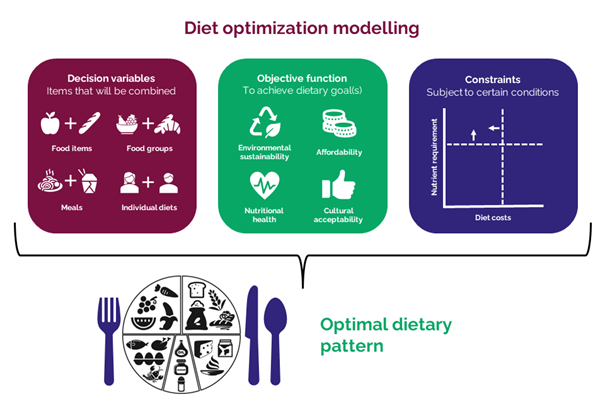
15 May Diet optimisation modelling for achieving healthy and sustainable diets
This Thought for Food discusses the application and potential of diet optimisation modelling for achieving healthier and more sustainable diets.
The global food system is exerting greater pressure on the planet, and along with climate change, widespread biodiversity loss, and water depletion and pollution is causing major planetary problems. This while it fails to serve its main purpose as defined by the World Health Organisation and Food and Agriculture Organisation: providing nutritious, safe, affordable, accessible, equitable, and culturally-appropriate food for all. As the world-population continues to increase, it is needed to change the way we produce and consume our food to pave the way for healthy and sustainable diets for everyone.
To accelerate this transition, governments, industry, and organisations are required to make major decisions. Diet optimisation models can identify future dietary patterns that meet one or more of the dimensions of sustainable diets, and thereby support decision making. As greater emphasis on these models was observed in scientific literature over the last years, it is worth understanding optimisation modelling with respect to diets and nutrition. Why do we need all those different models? What are their purposes? What should you keep in mind when interpreting results? And what is their future potential?
Basics of diet optimisation modelling
Diet optimisation models aim to find the optimal combination of foods to achieve specific dietary goals while meeting various conditions (Figure 1). Such models include three main components: decision variables, an objective function, and constraints. Decision variables represent items that the model can combine and, in the context of dietary optimisation, usually concern food items, food groups, meals, or individual diets. The objective function defines the goal(s) of the model, such as minimising environmental impacts and cost of the diet. Constraints could be set to ensure that the outcomes of the model meet a set of conditions, such as nutrient requirements.

Types of diet optimisation models
As research questions differ, different diet optimisation models contain different sets of decision variables, objective functions, and constraints. For instance, while one model may prioritise consumer acceptability as it aims to find realistic dietary changes for the short term, another model might focus on identifying the most healthy and sustainable dietary pattern for the long term. Here, we will focus on the variation in decision variables.
When using food items as decision variables, the model makes combinations of food items, such as apples, whole grain bread, or milk. An example of a food item-based diet model is the Sustainable Nutrition Initiative®’s iOTA Model®. One of the advantages of a food item-based model is that for example the nutrient contribution of a food item to the total nutrient content of the diet, or the contribution to the total environmental impact can be estimated. Such resolution in a dietary optimisation model offers valuable insights. Besides, new food items, such as emerging plant-based foods, can be added to the list of available food items and can be chosen by the model to be part of the optimal diet. On the other hand, food item data may be prone to data errors, for example regarding their nutrient content or environmental impact, and model output may result in diets including only a handful of food items, which may be unrealistic from both a consumption and production point of view, but could provide extremely low environmental impacts.
In a food group-based model, which makes combinations of food groups such as fruits, grains, and dairy, the average data of the food group provides more moderate values. As such, insights obtained from these models is less detailed than those from food item-based models, given that food items within a food group can vary notably in their nutrient content and environmental footprint. On the other hand, using food group-based models, the challenges regarding data errors and unrealistic model outputs become less of a problem. Besides, these models are suitable for developing food-based dietary guidelines, as guidelines are usually provided at the food group level. For food item and food group-based diet models, food consumption data is not required, which can be an advantage in case this is not available or provided in good quality.
Meal-based models may provide the most tangible diets, as the composition of meals, i.e., its structure and the set of recipes, are maintained in the optimised diet. For instance, common combinations such as milk with cornflakes or pasta with tomato sauce will be retained. Meal-based models could be useful for improving school canteen meals or menus. In these models, both existing recipes or food consumption data could be used.
In diet-based models, not only basic interrelationships within meals are maintained, but also between meals. For example, the model corrects for the combination between a smaller breakfast and larger lunch, as well as includes snacks that are consumed throughout the day. For these models, food consumption data of the population of interest is required, and therefore it may not be possible to find ‘the perfect diet’ if this diet is not currently consumed by an individual in the population. Nonetheless, the identified optimal diet should be more acceptable to consumers as it uses better practices of peers and stays within current dietary habits. SHARP is an example of a diet-based model.
Considerations while interpreting results
To effectively make use of diet optimisation modelling, some considerations should be kept in mind when interpreting results. First, comparing diet optimisation models is extremely complex. For instance, two French studies both aimed to model optimal ratios of animal to plant protein in the diet that are compatible with the fulfilment of all nutrient requirements. While one study found that the percentage of animal protein in the diet could go as low as 20% to ensure nutritional adequacy, the other study demonstrated that this should be at least 45%. Since both studies used the same dietary data as a starting point, this substantial difference in model outputs was mostly related to the selection of objective functions and constraints. It should be noted, however, that diet optimisation models can also complement each other and could provide more holistic insights in healthy and sustainable diets in all its dimensions, as well as for specific dietary contexts. Despite variations in optimal diets among different models, the general trend is towards diets more reflective of dietary guidelines, rich in whole plant foods and complemented with low quantities of meat, to overcome environmental sustainability challenges.
Another important consideration is that diet optimisation models can only capture a fraction of the complexity that our food system entails. For instance, these models are not (yet) able to consider crucial aspects such as social dynamics and local/contextual factors that are more difficult to quantify There is also the missing link between the consumption and production side of the food system in diet optimisation models, as suggested changes in consumption are not (yet) translated to the corresponding changes in the food production chain. Most models run on fixed environmental impact and cost data calculated based on the current situation. However, if consumption patterns change, significant adjustments will likely be necessary on the production side as well, leading to different environmental impacts and costs related to the food items. Additionally, more physiological aspects such as the lack of nutrient bioavailability adjustments, quality of nutrient requirements, and data quality in general are important to consider when interpreting results. Some advances have been made where models have included co-production links, such as the relationship between meat and dairy production, and nutrient bioavailability.
Future potential
Diet optimisation models as currently available/published have room for continued improvement. A valuable improvement would be to incorporate production-related variables or link these models with production-focused models to provide a more thorough understanding of the sustainability challenges across the entire food production and consumption chain. An ongoing comparison between the SHARP (diet optimisation model) and CiFoS (biophysical optimisation model that aims to produce a healthy diet for a growing population within planetary boundaries) models was made by researchers of Wageningen University & Research. The preliminary results revealed that these models can complement each other on various aspects, including the time scale, i.e., solutions for the upcoming years (SHARP) versus upcoming decades (CiFoS), geographic scale, i.e. regional or national (SHARP) versus continental or global (CiFoS), and an individual (SHARP) versus population (CiFoS) approach. These complementary outcomes could be used in conjunction to provide a more holistic insight in sustainable healthy diets.
Another potential opportunity is to transform diet optimisation models into online interactive tools. By making these models publicly available, as is the intention for the iOTA Model®, decision makers across various sectors can directly engage with the models to explore synergies and trade-offs between sustainability aspects and tailor these to their specific contexts. Recently, the World Health Organisation launched the Diet Impact Assessment model as an interactive modelling tool for exploring the health, environmental, and affordability implications of dietary changes in various countries. Such tools can support stakeholder engagement and foster the transition towards healthier and more sustainable diets.
Take home message
To get a grip on current food system challenges, diet optimisation models can be a useful tool to support informed decision making. Although there is not yet a ‘gold standard’, results of diet optimisation models generally point in the same direction. The fact that these models could still be improved does not need to stop us from starting to move toward more healthy and sustainable diets. Linkage with other research fields, policy, and communities is needed to achieve dietary transition in practice.
This Thought for Food was written by Merel Daas and Samantha Heerschop, visiting PhD Students from Wageningen University & Research, the Netherlands, with the support of the SNi team.
Photo by Ella Olsson.





